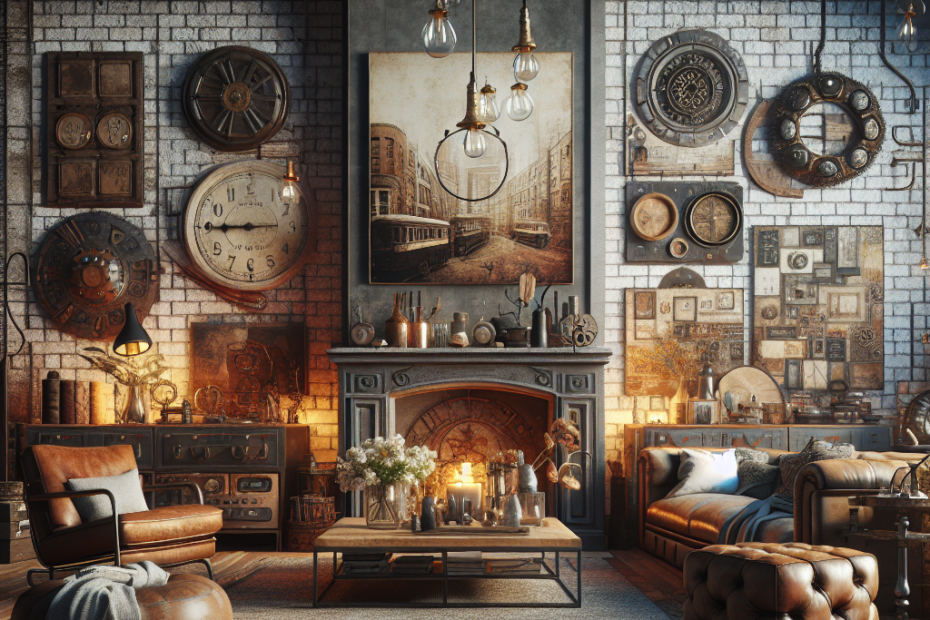They often find themselves enchanted by the charm and ruggedness of vintage industrial design. This popular interior design trend is a blend of the old and the new, where aged materials and contemporary lifestyle meet. With its roots dating back to the industrial age, this style has evolved over the years and is now celebrated for its ability to capture the raw essence of the early manufacturing era.
Vintage industrial design brings together the nostalgic elements of factories, warehouses, and manufacturing spaces, incorporating them into residential and commercial interiors. The style is marked by the use of reclaimed wood, exposed metal, and unfinished walls. They find the juxtaposition of naked pipes with pendant lighting and distressed furniture in this design style strikingly beautiful.
Characteristics of Vintage Industrial Design
The primary characteristic they notice about vintage industrial design is its emphasis on functionality with aesthetic appeal. Each piece of furniture or decor is not just for show but has a purpose, often harking back to its original use in an industrial setting.
| Element | Description |
|---|---|
| Materials | Reclaimed wood, exposed brick, aged metal, and concrete. |
| Colors | Neutral color palette emphasizing greys, blacks, and earthy tones. |
| Lighting | Pendant lights, Edison bulbs, and oversized lamps. |
| Furniture | Heavy, robust, often made of raw materials like wood and metal. |
Statistics on Vintage Industrial Design Popularity
They can witness the increasing popularity of vintage industrial design in various settings. According to data published by Statista, there has been a 23% rise in home design projects that incorporated industrial elements between 2017 and 2022. This design trend is not limited to homes; commercial spaces, particularly offices and cafes, have embraced this style significantly. The raw and functional appeal resonates well with businesses looking to project a creative and modern yet rustic vibe.
Incorporating Vintage Industrial Design in Modern Spaces
Integrating vintage industrial design elements into modern spaces requires a keen eye for balance. They should aim to blend textures and materials without overwhelming the space. Here is how they can do it:
- Start with a neutral color palette: Blacks, grays, and earth tones form the base of the style.
- Embrace open spaces: Avoid clutter and maximize light exposure.
- Use metal accents: Incorporate metal beams or pipework that are visible and add character.
- Select functional furniture: Think utilitarian, like heavy-duty wooden tables or metal stools.
Benefits of Vintage Industrial Design
They may find several benefits to choosing a vintage industrial design for their space. Firstly, it promotes sustainability by emphasizing the use of reclaimed and recycled materials. This style also creates a timeless aesthetic that does not easily go out of fashion, ensuring that their space remains trendy for years to come.
Moreover, this design offers flexibility in personalization, allowing them to incorporate different elements and textures to suit their tastes. The industrial look is easily customizable, making it ideal for those who enjoy evolving their interior designs over time.
Key Takeaways
- Vintage industrial design combines old-world charm with modern utility.
- The style is characterized by raw materials like metal and wood, and a neutral color palette.
- This design trend is gaining popularity, with a notable rise in residential and commercial settings.
- It’s eco-friendly and offers timeless appeal and personalization options.
FAQs
- What is vintage industrial design?
Vintage industrial design is an interior style that combines elements from the industrial era, such as metal and wood, with modern design concepts to create functional and aesthetic spaces.
- How can I incorporate vintage industrial design into my home?
Focus on using raw materials like exposed brick, metal, and reclaimed wood. Choose functional furniture and stick with a neutral color palette.
- Why is vintage industrial design popular?
Its popularity stems from its raw and authentic appeal, sustainability due to the use of recycled materials, and the timeless, adaptable aesthetic it offers.
- Is vintage industrial style suitable for small spaces?
Yes, by keeping the design minimal and using space efficiently, small areas can also benefit from this style.
- Can vintage industrial design be blended with other styles?
Absolutely, it can be complemented with elements from rustic, modern, or even minimalist styles, adding unique charm and individuality to the space.
